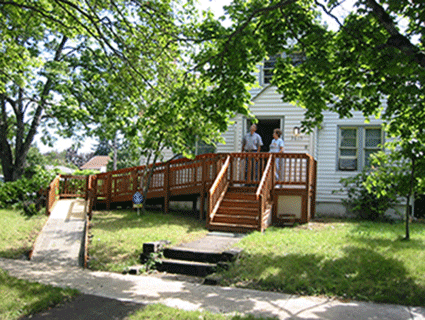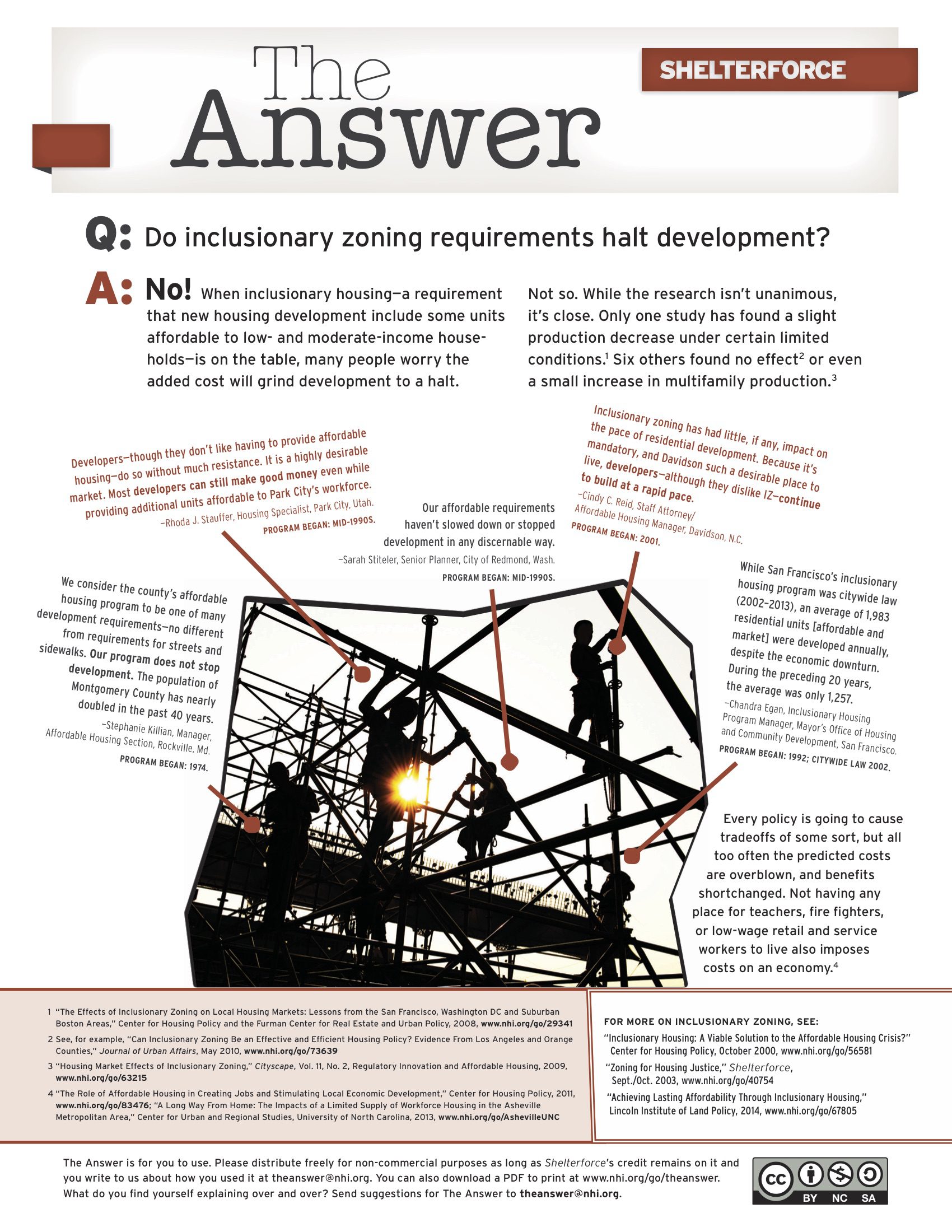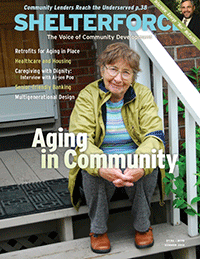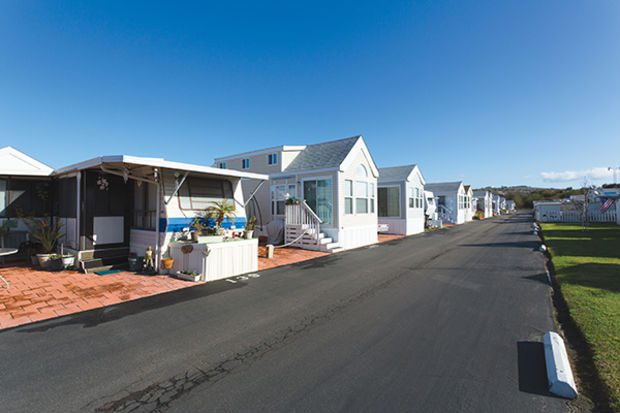
Photo courtesy of Unlimited Choices, Inc.
There is a universal truth in being human: we all age. And throughout human history, younger age groups have outnumbered older, making what is called an age “pyramid.” But this is changing. That pyramid will morph over the next 50 years into a rectangle, meaning the population of people over age 85, for example, will roughly equal the population under 5.
In 2014, the youngest members of the U.S.’ 78 million-strong baby boomer generation celebrated their 50th birthdays. This huge chunk of our population is on track to live longer than any American generation before, which threatens to put great stress on our healthcare and housing systems.
Our national response to this so-called “silver tsunami” is “much like our own [individual] response to aging,” says Kathryn Lawler, manager of the Aging and Health Resources Division of the Atlanta Regional Council. “We tend to ignore it until we’ve reached crisis mode.” Indeed, this tsunami will very soon wash over our communities, causing a crisis in not only the inventory of affordable housing, but the appropriateness of this housing stock to accommodate an aging population.
The majority of older adults prefer to remain in their current homes and communities as they age, commonly called “aging in place.” For seniors who do not require round-the-clock care, research shows that aging in place is a physically and emotionally healthier choice than nursing homes. Enabling people to continue living in familiar surroundings can keep them engaged in their community for a longer period of time, providing physical activity and mental stimulation beyond the often impersonal setting of a nursing home. And it offers significant savings when compared nursing home care costs.
While many people do not make housing plans for their senior years for reasons of psychological avoidance, an increasing number do not make plans simply because they lack the financial resources. The National Council on Aging reports that over 23 million people aged 60 and older now live below 250 percent of the federal poverty level, while the Social Security Administration says that nearly 75 percent of single Social Security recipients aged 65 and older depend on Social Security for all or most of their monthly income. This has led to a shortage of affordable housing options, which many CDCs and others around the country are trying to address in a range of ways.
Follow the Funding
Advocates assert that if aging in place is the better option, then we must consider the affordability, safety, and appropriateness of the actual places in which people want to age. Strategies encompass everything from designing (and redesigning) neighborhoods to be more walkable and accessible to public transportation to providing subsidy for homeowners to modify their homes for increased livability, constructing new developments with elements of “universal” design, and offering on-site services and opportunities for seniors to be active in the community.
“The problem is complex,” says Frank Woodruff, executive director of NACEDA, the National Alliance of Community Development Associations. “There are some in the community development field who are trying to plan for people who currently own their home to enable them to meet future needs, but there is relatively little out there in terms of resources for senior development.” Woodruff notes that HUD’s Section 202 Supportive Housing for the Elderly Program, which provided capital advances for construction, rehabilitation, or acquisition of supportive housing for very low-income seniors as well as rent subsidies to help make them affordable, “has been dead for a long time.”
“When it [202] and similar programs were funded in the ’80s, a lot of current developments were built. They are now reaching their decline, and predated universal design,” says Woodruff.
Politically, he says, “preferred populations come in and out of favor, and the current movement is focused on families, the middle class, and veterans. We’re in a place right now [where] seniors are out of favor. They’re just not the focus.”
For Betsy Crum, executive director at the Connecticut Housing Coalition, the reasons her group isn’t focusing on senior housing right now are not political, but practical. “We had a glut of elderly housing in the 1980s [as a result of] a fair amount of HUD- and state-financed public housing in Connecticut—15,000 units, a lot of which was senior housing,” she explains. Alluding to NIMBY attitudes, Crum says in the coalition’s region, which has a mix of poor urban and wealthy suburban neighborhoods, senior housing has been the “easy” affordable housing to build, even though more family housing was what was needed. Her organization has therefore primarily focused on getting family and supportive housing built.
But Crum has noticed an uptick in need. She says her first inkling of the issue was noticing a distinct increase in the age of their service area’s homeless, disabled population. She agrees the time to talk about senior housing is now, but believes “we’re approaching the problem in an uncoordinated way,” and cites a gap in knowledge of the scope of the problem.
“How many people are going to go from a place of self-sufficiency to needing subsidized housing?” she asks. “As we’re talking to funders, they’ll say, ‘What’s the market?’ For the homeless, we have this huge database, [but] we don’t have a good handle on the numbers [for seniors]. There’s so much need, [and] organizations are going to go after what they think is going to be funded.”
The need is not only showing up in Connecticut. “We have wait lists, particularly at our 202 properties because they come with subsidized units—residents only pay 30 percent of their income,” says Curtis Johnson, director of the Diocesan Housing Services Corporation of the Diocese of Camden in New Jersey. One of their wait-list buildings is located in a more urban setting, near shops and restaurants (“It’s next door to Dunkin Donuts. They love us,” he laughs). With subsidy, residents pay an average of $250 out of pocket toward the $750 per month rent. “It allows them to have disposable income, buy their medication,” he says. In the six southern counties of New Jersey in which DHSC operates, the communities are a broad mix of urban, suburban, and rural, and two of the counties have the lowest incomes in the state.
Johnson, who has been with DHSC for 14 years, says they began with two senior developments, when 202 funding was strong. The organization saw there was a need, and now operates eight senior developments. But government funding has dwindled. They have begun to rehab older projects by upgrading electrical systems and installing energy-efficient appliances and windows. They would like to do more retrofits, but are waiting, hoping that funding will increase as the economy improves.
Johnson says the only program currently working for them is the Low Income Housing Tax Credit (LIHTC), and they use their connection with the diocese to help with land acquisition. “We go to parishes with underutilized or unused properties,” says Johnson. “In many instances the properties are sold to DHSC for a fraction of their market value.”
Having access to land connected to a parish also helps ensure residents aren’t isolated. “Part of our parish-based strategy is to be where our parishes are, not just folks of Catholic faith, but people who are very community oriented,” says Johnson. “They’ve already had a food [pantry] set up, they know where the isolated folks are. That’s one of the things that makes us an attractive option—people can stay in their community.”
Still, there’s more need than they can serve. “I lean on my reps and tell them that we need the 202 [program] or something like it,” he says. “I know it’s expensive, but either we’re going to be a civilized society, or less than. How you treat your poor is a reflection of where your values are.”
With 202 funds gone, DHIC, a nonprofit housing developer in Raleigh, N.C., is also utilizing LIHTCs. Executive director Gregg Warren says demand for senior housing has increased as the native population of seniors has grown, along with increased in-migration of seniors following family and seeking warmer climates—and affordable housing.
In existence for over 40 years, DHIC now has almost 600 units of senior housing and continues to build. Warren says all of their new construction is considered universal design. “A lot is very simple stuff: level entry thresholds, hallways are wider for turnaround in bathrooms, grab bars in bathrooms,” he lists. “All of those things are standard practice, and some are mandated by the Housing Finance Agency.”
Warren says DHIC has also encountered NIMBYism related to the other types of housing they develop, but has used senior housing strategically to combat it. “As we develop rental housing, we find there are three populations: families, seniors, [and] supportive housing for men, women, or veterans coming out of shelters, rehab programs, etc. It’s not uncommon for us to have NIMBY battles, and the more politically acceptable housing to build is senior housing.”
What DHIC has done to overcome this obstacle is combine developments into intergenerational campuses, in which family units are adjacent to age-restricted communities. This serves two purposes: supporting seniors who want to live in an intergenerational setting and assuaging NIMBY fears.
Independent living services, which they contract out, are a feature of DHIC’s developments as well. Coordinators have regular office hours and help with social services like food stamps, home visits, enrollment in Medicare Part D—“a whole range of activities that allow residents as much capacity as possible, for as long as possible,” says Warren. But the funding is always a stretch. “There’s not a lot of incentive for senior housing to include service coordinators in their budgets, so our efforts to do this are more on a mission basis than an economic basis.”
Connecticut is luckier; Crum says the service-enriched model, which adds resident service coordinators to senior housing developments, has a “healthy line item” in her state’s budget.
Aging in a “Safe” Place
According to the Centers for Disease Control, there were 2.5 million non-fatal falls among adults age 65 and older in 2013, and in 2012, the medical costs to treat these falls were $30 billion. While many falls can be attributed to existing health conditions, hazards in the home are a significant cause as well. And while poor lighting, trip hazards like rugs, and the absence of grab bars in the bathroom can make living at home for seniors dangerous, other elements can make living at home impossible.
Enter Unlimited Choices (UC), an Oregon nonprofit that does retrofits, modifications, and critical repairs to single- and multi-unit dwellings for lower income seniors and others with mobility limitations. Founded and operated by Brenda Jose, UC began around the time the Americans With Disabilities Act was passed, and uses a combination of Dept. of Housing and Urban Development Community Development Block Grant (HUD CDBG) funds, Medicaid, contractor trainings, and fees for service from higher income individuals to operate. UC works with local social service agencies to identify individuals in several jurisdictions in and around Portland whose dwellings need modifications. HUD-assisted homes qualify for their services, as do multi-unit buildings in which 51 percent of the residents meet income guidelines. In rented homes, landlords are obligated to allow a tenant with a disability to make the necessary modifications—which Jose says they do, as well as keep the modifications in place for future renters.
The most common modifications UC makes are cuts to bathtubs to make them wheelchair accessible, removing glass shower doors, adding ramps, widening doorways, rebuilding stair landings to create level entryways, deepening steps for walkers, installing grab bars and hand-held shower heads, modifying toilets, adding floor-to-ceiling “super poles” for paraplegics, and repairing sidewalks. Often, other safety or livability issues will come up in the process, and UC works with weatherization programs to make homes more energy efficient and to upgrade heating systems.
Home modifications and repairs that enable a person to live independently and safely clearly improve residents’ quality of life, but Jose has numbers to prove that UC’s work saves public money, as well.
From 2002 to 2011, UC compared the cost of their services for 90 people who could not live in their homes if repairs and/or modifications were not done, to the cost of placing those individuals in other forms of care. UC’s repairs and modifications for the group cost $89,101. Had they been placed in adult foster care, the mid-range cost to Medicaid over the nine-year period would have been more than $4 million. The cost of placement in an assisted living facility would have been $5.5 million, and for nursing home care, the cost would have been $20.8 million.
In speaking with local policymakers and funders, Jose says it’s these numbers that get people’s attention. “When I say, ‘Grandma wants to stay at home,’ they ask, ‘Why should we spend money on these people?’ When I talk about the savings, they’re all ears.”
Getting It Done
In her position as manager of the aging and health resources division at the Atlanta Regional Commission, an intergovernmental coordination agency for a 10-county area including Atlanta, Kathryn Lawler meets with state and local government leaders to discuss aging, using Atlanta as a model. “There is no lack of resources—we are spending millions of dollars on infrastructure, [but we] need to spend money to reflect who we are,” she says. “We still build as if we all die at 63.”
As a leader in the conversation, Lawler believes that aging in place is simply about good growth. “It’s about choice and options. Sometimes it’s affordability; sometimes it’s the right housing or the right transportation. And a community that keeps people active and engaged.”
“The challenge in Atlanta, and in other cities,” says Lawler, is getting “the momentum to make the change, and the scale that’s going to matter.” The city’s steps toward this include a 24-hour counseling hotline for seniors in crisis, and ARC’s project demonstration last year—creation of an “age-friendly” neighborhood for two days in the Sweet Auburn neighborhood of Atlanta, complete with walkable streets, more benches for people to stop and rest on, and outdoor attractions. Lawler says the project attracted the media and captured people’s imaginations. “Sweet Auburn was about exploring what we needed to learn, but also [about] building momentum.”
For the Plough Foundation in Memphis, Tenn., societal and personal circumstances were catalysts that shone a light on aging issues. Several years ago, the board began to take a serious look at aging when their numbers of aging-related proposals increased, and several board members were dealing with issues related to aging family members. The foundation, which has a local focus, hired Katie Midgely as its director of research and evaluation, and she took a systematic approach to compiling data on their region’s demographics and areas of need, as well as conducting focus groups and telephone surveys with the county’s elderly population, the majority of which is low income.
The result was a commitment of resources by the foundation in two key areas: home modifications and elder maltreatment. In December 2014, the foundation announced $12 million funding over three years for nearly one dozen programs to help feed, house, and provide care to Shelby County seniors. Grants include the Elder Home Rehab Program, which plans to rehab 500 homes with minor repairs and accessibility modifications, roof replacement, and weatherization. Midgely says the program, which is a collaboration of Memphis Habitat for Humanity, local faith-based organization Service Over Self (S.O.S.), and the Memphis Light Gas & Water Division, will enable at least 500 low-income seniors to stay in their homes.
Finding New Allies
Although it may not have kept pace with the increase in the senior population, private interest in issues of aging has increased. John Feather, executive director of Grantmakers in Aging (GIA), recalls their annual meeting in 1995—“we sat at ten tables . . . that was all of us.” Today, the organization has over 110 institutional members and a goal, named GIA 2.0, to dramatically increase the percentage of philanthropy addressing aging by 2019.
GIA works with funders to help them see opportunities through “an aging lens” to expand their grantmaking. “We do not tell them what the needs are; we help them assess needs in their community and think about how what they’re doing now can extend to aging.”
Feather says the challenges seniors face are very similar to those of the low-income population in general. “The housing issues are critical, and federal [funding] is not coming back any time soon. We need to be providing support to the private sector to help with these services.”
And so, in conjunction with National Cooperative Bank and Leading Age, GIA has designed a lending program called LeverAge that Feather says he “hopes community development folks will want to be involved in.” The program can be used to reposition, expand, or add to aging services, housing, and long-term care programs in which at least 40 percent of participants earn no more than 80 percent of the area median income. It is these kinds of partnerships, with what he calls “not the usual suspects,” that are absolutely essential to their work.
Echoing the sentiments of others, Feather believes aging has a stigma, and in many instances is not even discussed. But the issue is critical. “Building political support is crucial, but really hard if you make it age-specific,” he says. “If you say, ‘We’re building sidewalks so seniors can walk and kids can get to school,’ that’s fine. It’s the coming together of the community—old people, young people—that starts building the political support to get attention.”





Comments